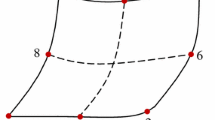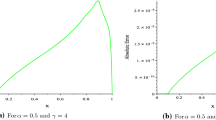Abstract
Accurate evaluation of nearly singular integrals plays an important role in the overall accuracy of the Boundary Element Method (BEM). A new approach for the evaluation of nearly singular integrals particularly those with severe near singularity is described in this paper. This method utilizes a degenerate mapping to first reduce near singularity and then employs a variable transformation to further smooth out the resultant integrand. The accuracy and efficiency of the method are demonstrated through several examples that are commonly encountered in the applications of the BEM. Comparison of this method with some of the existing methods is also presented.
Similar content being viewed by others
References
Anantharaman N, Mukherjee S (1993) A mapping method for numerical evaluation of two-dimensional integrals with 1/r singularity. Comput Mech 12: 19–26
Banerjee PK, Wilson RB, Miller N (1985) Development of a BEM large system for three-dimensional inelastic analysis. In: Cruse TA (ed) Proc. ASME Conf. advanced topics in boundary element analysis. ASME, New York, pp 1–20
Cruse TA, Aithal R (1993) Non-singular boundary integral equation implementation. Int J Numer Methods Eng 36: 237–254
Dallner R, Gunther K (1993) Efficient evaluation of volume integrals in the boundary element method. Comput Methods Appl Mech Eng 109: 95–109
Duffy MG (1982) Quadrature over a pyramid or cube of integrands with a singularity at a vertex. SIAM J Numer Anal 9(6): 1260–1262
Elliott D (1998) Sigmoidal transformation and the trapezoidal rule. J Aust Math Soc Ser B 40: E77–E137
Elliott D, Johnston PR (2007) Error analysis for a sinh transformation used in evaluating nearly singular boundary element integrals. J Comp Appl Math 203: 103–124
Elliott D, Prössdorf S (1995) An algorithm for the approximate solution of integral equations of Mellin type. Numerische Mathematik 70: 427–452
Gao XW, Davies TG (2002) Boundary element programming in mechanics. Cambridge University Press, Cambridge
Gray LJ, Martha LF, Ingraffea AR (1990) Hypersingular integrals in boundary element fracture analysis. Int J Numer Methods Eng 29: 1135–1158
Guiggiani M (1991) The evaluation of Cauchy principal value integrals in the boundary element method—a review. Math Comput Model 15: 175–184
Hayami K (1990) A robust numerical integration method for three dimensional boundary element analysis. In: Tanaka M, Brebbia CA, Honma T (ed) Boundary elements XII., vol 1. Computational Mechanics Publication, Southhampton, Springer, Berlin, pp 33–51
Hayami K (1992) A projection transformation method for nearly singular surface boundary element integrals. In: Breddia CA, Orszag SA(eds) Lecture Notes in Engineering, vol 73. Springer, Berlin
Hayami K (2005) Variable transformations for nearly singular integrals in the boundary element method. Publ RIMS, Kyoto Univ 41: 821–842
Hayami K, Brebbia CA (1988) Quadrature methods for singular and nearly singular integrals in 3-D boundary element method. In: Brebbia CA (ed) Boundary elements X., vol 1, Southhampton, Springer, Berlin, pp 237–264
Hayami K, Matsumoto H (1994) A numerical quadrature for nearly singular boundary element integrals. Eng Anal Bound Elem 13: 143–154
Huang Q, Cruse TA (1993) Some notes on singular integral techniques in boundary element analysis. Int J Numer Methods Eng 36: 2643–2659
Johnston PR (1999) Application of sigmoidal transformations to weakly singular and near-singular boundary element integrals. Int J Numer Methods Eng 45: 1333–1348
Johnston PR (2000) Semi-sigmoidal transformations for evaluating weakly singular boundary element integrals. Int J Numer Methods Eng 47: 1709–1730
Johnston BM, Johnston PR (2003) A comparison of transformation methods for evaluating two-dimensional weakly singular integrals. Int J Numer Methods Eng 56: 589–607
Johnston BM, Johnston PR, Elliott D (2007) A sinh transformation for evaluating two-dimensional nearly singular boundary element integrals. Int J Numer Methods Eng 69: 1460–1479
Johnston PR, Elliott D (2001) A generalization of Telles’ method for evaluating weakly singular boundary element integrals. J Comp Appl Math 131: 223–241
Johnston PR, Elliott D (2002) Transformations for evaluating singular boundary element integrals. J Comp Appl Math 146: 231–251
Lachat JC, Watson JO (1976) Effective numerical treatment of boundary integral equations: A formulation for three-dimensional elastostatics. Int J Numer Methods Eng 10: 991–1005
Li HB, Han GM, Mang HA (1985) A new method for evaluating singular integrals in stress analysis of solids by the direct boundary element method. Int J Numer Methods Eng 21: 2071–2098
Li Y, Obata T, Koguchi H, Yada T (1992) Some improvements of accuracy and efficiency in three dimensional direct boundary element method. Int J Numer Methods Eng 33: 1451–1464
Liu Y (1998) Analysis of shell-like structures by the boundary element method based on 3-D elasticity: formulation and verification. Int J Numer Methods Eng 41: 541–558
Moore MN, Gray LJ, Kaplan T (2007) Evaluation of supersingular integrals: Second-order boundary derivatives. Int J Numer Methods Eng 69: 1930–1947
Mukherjee S, Chati MK, Shi X (2000) Evaluation of nearly singular integrals in boundary element contour and node methods for three-dimensional linear elasticity. Int J Solids Struct 37: 7633–7654
Sidi A (1993) A new variable transformation for numerical integration. In: Brass H, Hämmerlin G(eds) Numerical integration IV. Birkhäuser, Basel, pp 359–373
Telles JCF (1987) A self-adaptive co-ordinate transformation for efficient numerical evaluation of general boundary element integrals. Int J Numer Methods Eng 24: 959–973
Telles JCF, Oliveira RF (1994) Third degree polynomial transformation for boundary element integrals: further improvements. Eng Anal Bound Elem 13: 135–141
Wu S (1995) On the evaluation of nearly singular kernel integrals in boundary element analysis. Numer Method Eng 11: 331–337
Wu S, Lu P-A (1996) On the evaluation of nearly singular kernel integrals in boundary element analysis—some improved formulations. Comm Numer Method Eng 12: 85–93
Yun BI (2006) A generalized non-linear transformation for evaluating singular integrals. Int J Numer Methods Eng 65: 1947–1969
Author information
Authors and Affiliations
Corresponding author
Rights and permissions
About this article
Cite this article
Ye, W. A new transformation technique for evaluating nearly singular integrals. Comput Mech 42, 457–466 (2008). https://doi.org/10.1007/s00466-008-0262-6
Received:
Accepted:
Published:
Issue Date:
DOI: https://doi.org/10.1007/s00466-008-0262-6




